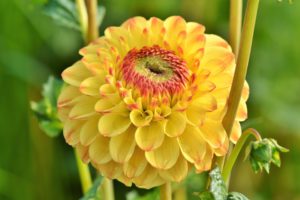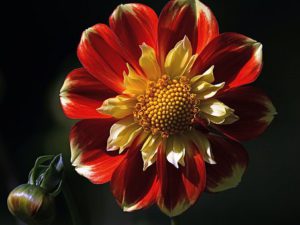Tips for Growing and Caring for Dahlias

Bring more flavor into your garden by installing dahlias these garden beauties produces beautiful flower bloom and will go to work for you by blooming from midsummer through autumn. Dahlias are not bulbs as some believe but are tubers that resemble or look somewhat like carrots. There are some 42 species from which to choose.
Dahlias belong to the aster family and are bushy herbaceous perennial which is native to Central America and Mexico. Its believe that these garden beauties have been in cultivation since the 1700 hundreds which is a long time ago. Because of their varieties, the flowers of dahlias come in many sizes so for more on how to grow and successfully care for dahlias continue reading and fill your gardens with an array of colorful flower blooms that are so amazing.
The planting location
Planting your dahlias in full sunlight will keep them growing at their best.
Soil Type
A good loamy soil that will absorb the right amount of water along with good drainage is ideal.
Watering Methods
The soil of dahlias should be moist, never overwater or have the soil waterlogged which will lead to root rot. Do not water the soil until the plant appears.
Fertilizing Methods
To keep your dahlias blooming their best the use of a fertilizer that is high in potassium and phosphorus but low in nitrogen is ideal. Fertilizers such as 10-20-20 or 5-10-10.
Garden pest of dahlias
Garden pests of dahlias.

- Aphids
- Cucumber Beetles
- Mites
- Slugs
- snails
- Earwigs
- Deers
Aphids
Aphids are pear-shaped and can either be black, red, yellow, green, or brown. Aphids are among the sucking insect group and will cause flowers to drop. These garden insect pests also produce a sticky substance known as honeydew. This honeydew is their excrement that causes sooty mold to form. Applying soapy water or insecticidal soap will bring aphid infestation under control.
Cucumber Beetles
Cucumber beetles feed on the petals of dahlias other than that they are not a real threat.
Slugs and Snails
Slugs and snails are among the chewing garden pests that cause injury by feeding on the plant. To combat slugs and snails apply snail bait about 2-2 1/2 weeks after installing your dahlias. Continue to apply baits throughout the growing season.
Mites
Spider mites are so tiny that they can hardly be seen, their color can either be yellow, green, red, or brown these garden insect pests causes damage by sucking the plant’s sap or fluids. Signs of these mites are spider webbing, the leaves become discolored with brown flecks also. The leaves will also fall from plants that are infested, the use of insecticidal soap or horticultural oil will bring them under control. Before applying insecticides read and follow the manufacturer’s directions.
Earwigs
Although these garden insects help to eliminate insect pests that will destroy your plant they too cause damage by eating parts of plants leaves along with leaving behind their excrement which is black. To control earwigs the use of diatomaceous earth will offer help. Diatomaceous is only effective once the ground is dry, placing a ring of diatomaceous around your plants will give results.
Deers
To keep deers away install plants around your dahlias, garden plants such as peonies, lavenders, salvias, sage, etc… are an offense to them and will keep deers at bay.
Diseases of dahlias
Keep a watch for these diseases and treat them once spotted.
- Aster Yellow
- Mosiac Virus
- Stem Rot
- Botrytis Blight
- Powdery Mildew
Aster Yellow
Leafhoppers are the culprits behind this disease, plants which are infected by aster yellow die because there is no known cure.
Mosiac Virus
This virus will cause the leaves of plants to be distorted along with causing the plant to stunt. There is no known cure except to properly dispose of the plant.
Stem Rot
Stem rot disease is encouraged by soils that are poorly drained. Signs of this disease are rings that are white which appear in the soil around the stem. If this disease is allowed to persist will kill both the stem and the tubers. Installing your dahlias in soil that has good drainage at the time of planting along with giving them the right amount of water will keep your dahlias from this disease.
Botrytis Blight
Botrytis blight will cause buds to rot along with covering plants with a gray powdery mold. Bring this disease under control by removing infected plant parts and disposing of them.
Powdery Mildew
Powdery mildew is a white powdery substance that coats or covers the leaves of garden plants. Control powdery mildew by spacing plants apart for proper airflow. The use of sprays label for this disease will also bring control. Before applying read and follow the manufacturer’s label for the best results.
Ideas where to install dahlias
1. Install dahlias in containers and place the container on either side of your door entrance.
2. Install these garden beauties around the truck of trees providing a colorful look.
3. Place dahlias in your garden plant bed.
4. Plant along your garden path walkway.
5. Grow dahlias indoors.
6. Use dahlias as foundation plants.
Container grown dahlias
When growing dahlias from a container the container should have drain holes for water drainage. The soil should be a good loamy soil that will hold the right amount of moisture but will allow excess water to drain, Place the container in an area that gets plenty of sunlight. Keeping the soil moist but not waterlogged is ideal. Fertilize as recommended above.
Growing dahlias indoors
A great way to bring that much-needed colors indoors is growing dahlias indoors and placing them in a sunny location, choose containers that are 12 inches deep to place your dahlias seeds or tubers, the use of a good potting soil that is loamy and well-drained is ideal. Fill the container with soil leaving a space of about a few inches from the top, add your seeds or tuber to the soil, if you are planting a tuber the tuber should be placed 4-6 inches in the soil in the center of the container with the eye of the tuber facing the upward position.
The soil should be somewhat moist during this process and not waterlogged, don’t allow the soil to dry out either which can lead to dahlias decline. Once your dahlias sprouts continue to water and fertilizer with a quick release or liquid feed fertilizer. A liquid feed fertilizer that is low in nitrogen is ideal.
Fertilize your dahlias from June through September, before applying fertilizer read and follow the manufacturer’s directions for best results. As said earlier place containers in an area that gets lots of sunlight, a southern window is the best location. Once the colder months start to set in discontinue watering and store containers in a dark room with a temperature of 40 degrees.
Deadheading dahlias
To remove spent or faded flowers from your dahlias firmly grip the stem beneath the flower between your thumb and forefinger. Remove the entire flower head by pinching the stem.
Additional Information
1. Dahlias will have your garden teeming with bees and butterflies.
Some dahlias species
Here are just a few species to choose from.
1. Dahlia Pinnata.
2. Red Dahlia.
3. Dahlia’Bishop of Llandaaff.
4. Dahlia imperialis.
5. Dahlia Coccinea.
6. Sunflower.
7. Dasiy.
8. Zinnias.
9. Chrysanthemum.
The final word
Installing dahlias in your garden or landscape is a real treat, these garden beauties are bringing that much-needed flavor to many landscapes and garden designs both on residential and commercial projects. What I love about dahlias once installed you will have them for a long time giving that color pop which is so amazing give dahlias a try and see for yourself what the talk is all about trust me you will be so happy that you did as dahlias go to work for you.
About the author
Norman loves being in the garden, both at home and for his job....
he is 'Natures Little helper' being outdoors, growing his vegetables and flowers from an early age.
Now having spent over 22 years in the profession he want to give some of his knowledge to others...
his vast array of hints and tips you will find scattered over this site will help you no end growing plants in your garden.
